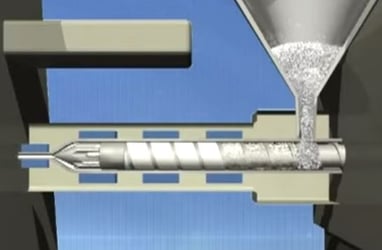Scrap and wasted materials are an aspect of manufacturing that every company wants to minimize. One automotive parts supplier was suffering from an alarming 15 percent reject rate, and significant material waste.
The manufacturer was processing Ultem at a temperature range of 680 to 700 degrees Fahrenheit. It was recommended that their operators use a high-temperature grade purging compound with advanced thermal stability at elevated temperatures.
The processor had been using a PF Grade compound to clean their machine, in line with the aforementioned recommendations. They were also following the purging instructions that their supplier provided them. Their machines were successfully purged at the end of each run, however, they were experiencing an odd problem.
The next morning, upon starting up their machine, the processor’s initial run would produce a black, tar-like substance. It appeared as though degraded purging compound was coming out of the barrel.
Getting To The Bottom Of An Unusual Issue
Clearly, the manufacturer was experiencing an abnormal problem that warranted investigation. To get to the bottom of the issue, we asked the processor several important questions:
“Did you purge until there was no further resin or contamination seen in the outcoming purge?”
“Yes. The purge was examined and NO contamination could be seen.”
“Did you turn your heat off?” (High-temperature PF grade purging compounds should not be left idle in your barrel above 700 degrees Fahrenheit for any period of time.)
“Yes. Machines are always turned off each night.”
“Were your barrels completely full, to ensure that no oxygen could enter?”
“No. The barrel was left empty.”
Solving A Costly Issue
Although the processor had been following the purging procedure, without sealing measures in place upon shutdown, oxygen was entering the barrel and causing carbon contamination.
With the machine at an elevated temperature before shutdown, the combination of heat and oxygen created degradation of the purging compound residue, which produced buildup of the black, tar-like substance on the screw. Even after a purge and emptying of the machine, there would always be some traces of purge or resin left on the screw because of the presence of oxygen.
Oxygen + Heat = Degradation
We recommended that the processor use a purging compound upon shutdown to seal their barrel.
Sealing For Significant Savings
As a best practice, always seal your machine – whether it’s being shut down for the night, weekend or even just taking a few hours off between runs. This practice saves you hours on startup, and has a huge impact on your scrap rates and material waste.
To seal your equipment, ensure the barrel is full of a thermally stable sealing-grade purging compound from the hopper through to the die head and/or hot runners (if required). This ensures that there are no openings, and thus, no way for oxygen to enter the machine.
In the case of this manufacturer, adopting a sealing process and preventing oxygen from entering the machine cut their reject rate upon startup from 15 percent to 4 percent, a 73.3 percent reduction in wasted materials. Overall, the automotive parts supplier is reaping the benefits to their bottom line.
Learn how the right purging compounds and procedures impact your process efficiency.








Comments